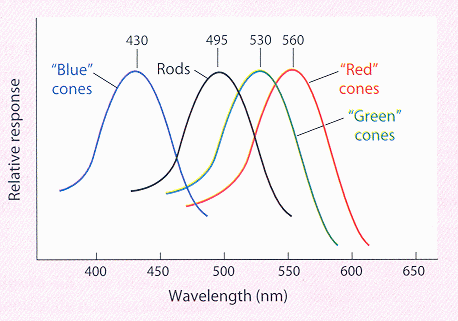


Next: S cones are more
Up: The retina
Previous: The retina
There are basically two different types of photodetectors in the retina:
- Rods (over 100 milliion) are adapted to dim light (e.g. nightlight) and
are therefore responsible for scotopic vision. They can respond to a single
photon. Six closely spaced rods, each stimulated by a single photon, will produce
a visible flash. But rods saturate quickly when the light intensity increases.
Moreover, rods are not sensitive to different colors. This is why we have very
poor color vision in the night. Their sensitivity to light as a function of
wavelengths is a smooth curve that peaks at about 495 mm. Foveal area does not have
rods. The density of rods peaks at about 20 degrees from fovea and monotonically
decreases at higher eccentricities.
- Cones (about 5 million) are not sensitive to dim light, but they are adapted
to bright light (e.g. daylight) and is responsible for photopic vision.
They can respond to bright light and never saturate at steady light level at
any intensity. There are three types of cones, called the L-, M- and S-cones because
they are respectively sensitive to light of long, middle and short wavelength (or
equivalently, low, middle and supra frequency). Their sensitivities as functions of
the wavelength peak at 564 mm, 533 mm and 437 mm, respectively. The L, M and S cones
are also referred to as the red, green and blue cones.






Next: S cones are more
Up: The retina
Previous: The retina
Ruye Wang
1999-11-06



